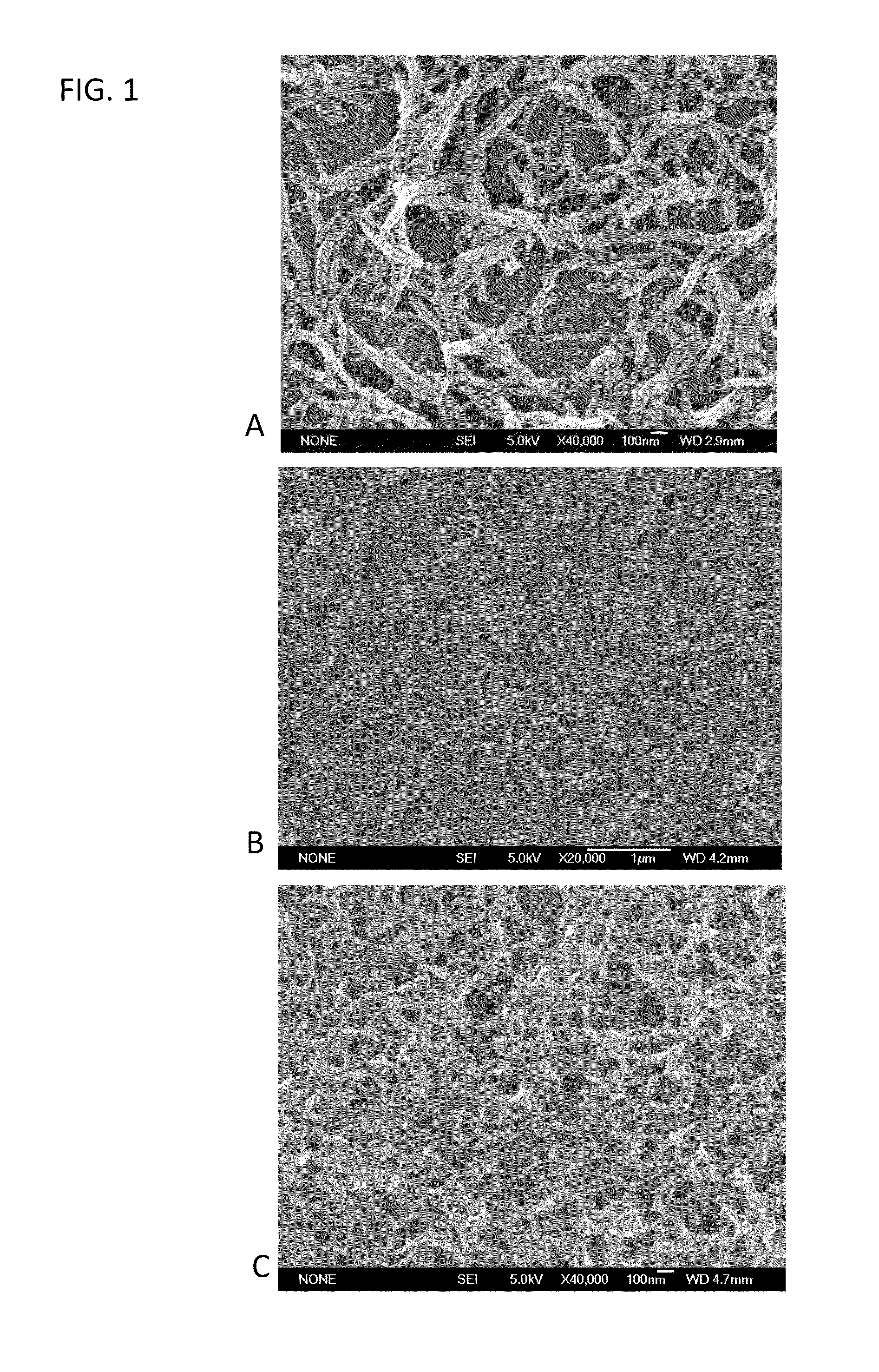Electrodes incorporating nanostructured polymer films for electrochemical ion storage
a technology of nanostructured polymer films and electrochemical ions, applied in the field of electrochemical ion storage, can solve the problems of poor processability, low solubility of conductive polymers, and few large-scale applications of conductive polymers, and achieve the effect of improving the wetability of the substra
- Summary
- Abstract
- Description
- Claims
- Application Information
AI Technical Summary
Benefits of technology
Problems solved by technology
Method used
Image
Examples
example 1
Synthesis of Polymer Nanofiber Material
[0080]In one embodiment, polyaniline nanofibers were synthesized by initiator assisted oxidative rapid mixing polymerization for 24 to 48 hrs, and purified either by dialysis, or liquid / liquid extraction. (See, e.g., Tran, H. D., et al., Advanced Materials 2009, 21, (14-15), 1487-1499; and Li, D. et al., Accounts of Chemical Research 2008, 42, (1), 135-145, the disclosures of which are incorporated herein by reference.) The doping levels of these organic conductors are controlled by the extent of purification; the longer the dialysis, or the more number of washes employed, the more dedoped the polymer nanofibers become. A stable colloidal dispersion of nanofibers is obtained after purification for over a period of one week via repeated dialysis, or by using multiple washes during liquid / liquid extraction. This aqueous dispersion can then be used for coating a substrate such as copper, and aluminum.
example 2
Preparation of Electrode
[0081]A metal surface is cleaned in oxygen plasma, increasing hydrophilic character, and affording the correct surface energy for the spreading and deposition of a nanofiber film. Typically, a metal electrode is cleaned between 30 s to 2 min—note that it is susceptible to degradation from prolonged oxygen plasma (3 min). Aqueous dispersions of nanofibers of polyaniline are mixed with an oil such as a hydrocarbon of heavy (chloroform, carbon disulfide, chlorobenzene), or low (toluene, benzene, hexane) density. A film is produced at the liquid / liquid interface between a binary system of immiscible solvents. An electrode needs to be in contact with the liquid / liquid interface for deposition to occur, and needs to be wet with an aqueous layer prior to polymer deposition. This is achieved by immersion of an electrode in water after treatment with oxygen plasma, and before spreading of film occurs. A film growth solution contains polymer, water, and oil contained i...
example 3
Electrode Testing
[0084]In one embodiment, electrodes (1.5 cm2) are punched from the nanopolyaniline (n-PANI) films on aluminum substrate provided by made in accordance with the processes set forth in Examples 1 and 2, above. In a glove box filled argon with argon, coin cells are assembled with the polymer film as the positive electrode in a lithium hall-cell. The electrolyte is 1 M LiPF6 in EC / DMC in accordance with the structure: (−)Li / 1 M LiPF6 in EC / DMC / PANT. SEM images of the undoped (FIG. 6A) and doped (FIG. 6B) electrodes made in accordance with this method show the nanofibrillar morphology of the conjugate polymers used.
[0085]The cells are then cycled at constant current between 2 V and 5.2 V for the anion intercalation (FIGS. 7A & 7B), and between 0.3 V and 3 V for the cation intercalation (FIGS. 8A & 8B). A rough estimate of the polyaniline electrodes capacity (considering a 200 nm thick film, 5% porosity and a density of about 1.2) gives 10 μAh for 1 ion intercalated per s...
PUM
| Property | Measurement | Unit |
|---|---|---|
| length | aaaaa | aaaaa |
| diameter | aaaaa | aaaaa |
| pore size | aaaaa | aaaaa |
Abstract
Description
Claims
Application Information
 Login to View More
Login to View More - R&D
- Intellectual Property
- Life Sciences
- Materials
- Tech Scout
- Unparalleled Data Quality
- Higher Quality Content
- 60% Fewer Hallucinations
Browse by: Latest US Patents, China's latest patents, Technical Efficacy Thesaurus, Application Domain, Technology Topic, Popular Technical Reports.
© 2025 PatSnap. All rights reserved.Legal|Privacy policy|Modern Slavery Act Transparency Statement|Sitemap|About US| Contact US: help@patsnap.com



